Two months after the massacre perpetrated by Hamas in Israeli territory, the situation in Gaza has changed dramatically. Israel has responded, it has done so harshly and despite much pressure from certain quarters of the international community that were meant to prevent the Israelis from responding. Hamas leaders are besieged in tunnels in the south of the Strip and in the north the terrorists are surrendering to the Israeli army.
The Israeli ambassador to the UN, Gilad Erdan, was clear in calling Hamas like the Nazis, like Isis, and "no country in the world would accept having such a neighbor." The Israeli government said early on that it would eradicate Hamas from the Gaza Strip, and the situation on the ground shows that Jerusalem is going all the way.
Initially there had been speculation that the hostage release negotiations might lead to an end to the conflict, but the hypothesis was implausible since this time Hamas's crimes are of such atrocity that the only denouement can be to eliminate its presence from Gaza, in agreement with Washington. After all, the Palestinian terrorist organization has clearly stated its willingness to repeat the actions of last October 7.
Another point of interest highlighted by Erdan concerns the mistake made in believing that getting economic aid into Gaza could turn Hamas into a political interlocutor concerned with the socio-economic development of the Strip. It did not. Hamas used the funding to build tunnels, underground command centers, to build and buy weapons, ammunition, rockets. All this, of course, at the expense of the people of Gaza who have received very little aid.
After all, it has long been evident that Hamas cares absolutely nothing about civilians, as stated by Hamas leader Musa Abu Marzouk himself, who stated that the underground tunnels are to "protect Hamas 'fighters' and the responsibility to protect civilians lies with the UN and Israel."
Hamas arsenals and command centers hidden in the basements of hospitals and alongside schools and kindergartens, all documented by the Israeli military, demonstrate how Hamas shields itself from civilians and then accuses Israel of targeting the population. Israel opted to temporarily deflect civilians to "safe zones" in the south of the Strip, and Hamas attempted to forcibly stop the fleeing civilians.
Now Hamas is in serious trouble considering that the Israeli army controls the northern part of the Strip while tightening its grip on Khan Yunis, where leaders, including the wanted number one, Yahya Sinwar, are apparently barricaded. The coming weeks will be decisive.
Researcher of Centro Studi Politici e Strategici Machiavelli. Graduated in Sociology (University of Bologna), Master in "Islamic Studies" (Trinity Saint David University of Wales), specialization in "Terrorism and Counter-Terrorism" (International Counter-Terrorism Institute of Herzliya, Israel). He is senior analyst for the British Islamic Theology of Counter Terrorism-ITCT, theItalian Team for Security, Terroristic Issues and Managing Emergencies (Catholic University of Milan) and the Kedisa-Center for International Strategic Analysis. Lecturer for security managerlaw enforcement and post-degree courses, he has been coordinator for Italy of the European project Globsec. “From criminals to terrorists and back” and is co-founder of Sec-Ter- Security and Terrorism Observation and Analysis Group.









Ringrazio per l’interessante articolo. Credo però che l’analisi manchi di una visione più ampia. Dopo l’attacco del 7 ottobre, ho continuato a chiedermi quali erano i veri fini di quel attacco devastante e orribile. Sicuramente i leader di Hamas non sono fessi e sapevano che l’azione stragista, avrebbe portato Israele ad una reazione violenta, su larga scala e risolutiva contro Gaza ed i suoi abitanti. I capi di Hamas hanno dimostrato un cinico disinteresse verso la popolazione civile Palestinese che è stata usata come carne da macello, inoltre nel sottosuolo/metropolitana di Gaza non mancavano né acqua, né derrate alimentari, né carburanti, ma erano riservati ai militanti di Hamas per proseguire la guerra fino alle estreme conseguenze. I poveri cittadini civili sono stati usati cinicamente per creare a livello mondiale, un clima di sdegno e ritorsione verso Israele, che possa indurre o costringere i paesi mussulmani confinanti ad allearsi, per scatenare una guerra santa contro i Sionisti, guerra che porterà il mondo verso il baratro.